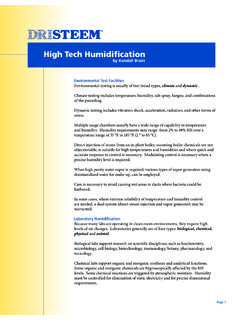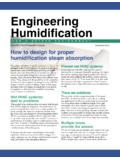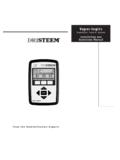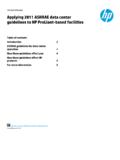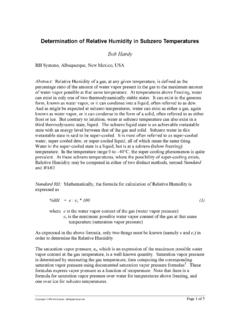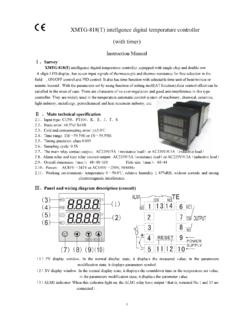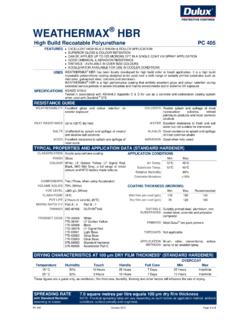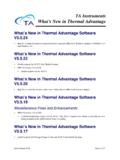Transcription of Humidity and Comfort - dristeem-media.com
1 Page Humidity and ComfortWhen all other factors affecting body heat loss remain constant, increasing the Humidity of the surrounding air makes us feel absorbs heat from our skin as it evaporates, thus cooling us. By controlling the Humidity we can vary the evaporation rate and thus affect how warm or cool we have been done on human Comfort under controlled conditions. The resulting criteria are based on skin sensation, psychological responses, and thermal effects. ASHRAE Comfort Standard 55-75 indicates a preference for a relative Humidity ranging between 20 and 50 percent and a dry bulb temperature between 73 and 77 Comfort analysis was made on groups of subjects under standard conditions (at rest or doing light office work) and wearing standard clothing (long-sleeved shirts and trousers).
2 These individuals submitted Comfort votes, which established a range of temperatures compatible with thermal Comfort . Eighty percent were thermally comfortable when all of the following six conditions were present: When activity is light office work or its equivalent. When standard clothing is worn. When air motion is 40 feet per minute. When relative Humidity is 40 percent. When mean radiant temperature is equal to the air temperature. When air temperature is between 72 and 78 study found that a 20 percent change in relative Humidity was equal to a one-degree F change in dry bulb temperature.
3 Indoor relative Humidity maintained between 35 and 40 percent is recommended for optimum Comfort during the heating STANDARD 62-1989 recommends: Relative Humidity in habitable spaces preferably should be maintained between 30% and 60% RH to minimize growth of allergenic or pathogenic organisms. Page Individuals have an ideal range of temperature and Humidity within which they perform best and feel most comfortable. Excessively high or low Humidity causes significant environmental and physiological at higher temperatures , dry air feels colder.
4 When people feel cold, they are uncomfortable and less productive. When the Humidity level is ideal, building temperatures can be lowered without changing the Comfort or productivity has been stated that the energy savings derived from a reduction in room temperature, as a result of proper humidification, will directly offset the cost of the energy consumed in producing that The following statements are excerpts from an ASHRAE paper entitled The Effect of Indoor Relative Humidity on Colds, prepared by the late Dr. George Green, Professor of Engineering of the College of Engineering, University of Indoor Relative Humidity in Winter The studies of the influence of relative Humidity quoted in this paper demonstrate a reduction in respiratory illness as the relative Humidity is increased up to 50%.
5 This would appear to be the optimum for health with our present buildings in cold climates will have excessive window and wall condensation at -10 C, 14 F outdoor temperature with 50% RH; therefore, this level cannot be maintained constantly. For reasons of health, it would be desirable to hold humidities as high as can be maintained without excessive building condensation. For many buildings with a high occupancy load, controls which keep the maximum Humidity , consistent with the outdoor temperature, are justified in view of the high cost of absenteeism resulting from the common An increase of indoor relative Humidity by humidification in winter significantly decreases the occurrences of absenteeism due to colds.
6 With preschool children, the investigation reports reduction of 50% in absenteeism in humidified over non-humidified schools. The reductions in absenteeism of adults was from 6 to 18% in similar investigations. It is recommended that winter indoor humidities should be kept as high as possible without causing building damage by condensation, but not to exceed 50% The reduction in absenteeism by winter humidification justifies its capital, operating, and energy costs. Humidity and Skin DisordersWinter itch, dermatitis, chapping, painful skin cracking at knees and elbows and where the skin meets the fingernails, plus brittleness and splitting of hair and nails can affect almost everyone, but elderly people in particular.
7 Maintaining a relative Humidity of 35 to 50 percent may be significantly effective in reducing these troubles. Hayfever and AsthmaHumidification does little or nothing to alleviate the reaction of the body to specific allergens. It can, however, minimize the formation of house dust, feathers, animal hair, insect scales, etc., which irritate people with asthmatic individuals have attacks that come on as a result of sudden temperature and/or Humidity changes. A constant Humidity level seems to help those : The Sterling bar graphSterling StudyFurther evidence of the health benefits of humidification, is provided by the following information excerpted from an ASHRAE paper prepared by Sterling, A.
8 Arundel, and Sterling, Unlike most gaseous and particulate contaminants that are primarily affected by indoor and outdoor sources and sinks, relative Humidity is also a function of air temperature. In addition to the effect of temperature, the selection of the Page most desirable range of Humidity is complicated by the conflicting effects of an increase or decrease in Humidity levels. For example, increasing Humidity may reduce the incidence of common respiratory infections and provide relief for asthmatics. On the other hand, an increase in Humidity may increase the prevalence of microorganisms that cause allergies.
9 Criteria for indoor exposure must balance both effects. The ideal Humidity guideline should specify a relative Humidity range that minimizes deleterious effects on human health and Comfort as well as reducing, as much as possible, the speed of chemical reactions or the growth of biological contaminants (which will impact human health and Comfort ). The Sterling bar graph summarizes the apparent association between relative Humidity ranges and factors that affect the health of occupants at normal room temperatures . The figure is constructed as a bar graph relating relative Humidity levels from 0% to 100% (shown along the horizontal axis) to (1) biological organisms (bacterial, viruses, fungi, and mites), (2) pathogens causing respiratory problems (respiratory infections, asthma, and allergies), and (3) chemical interactions and ozone production.
10 The decreasing width of the bar represents decreasing Comments:The bacterial population increases below 30% and above 60% relative Humidity . The viral population increases at relative Humidity below 50% and above 70%. Fungi do not cause a problem at low Humidity ; however, growth becomes apparent at 60%, increases between 80% and 90%, and shows a dramatic rise above 90%. Mites require Humidity for survival. Growth in the mite population responds directly to Humidity levels in excess of 50%. Respiratory infections increase at relative Humidity below 40%; however, there is little information on effects of Humidity in excess of 50%.
